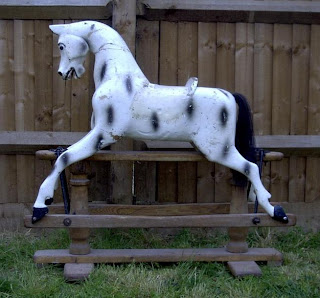
MERRY CHRISTMAS!
 Reading to rocking horses...
Reading to rocking horses... End of the sanding in sight!
End of the sanding in sight! Trying to think of something interesting to say about sanding...
Trying to think of something interesting to say about sanding... Sanding the hoof rails
Sanding the hoof rails A long job
A long job Now this is exciting...
Now this is exciting... It's not fair! I need more hours in the day...
It's not fair! I need more hours in the day... Zaphod, complete with his original saddle-back.
Zaphod, complete with his original saddle-back. This photo shows how I cut the 60 degree slot in Zaphod's back for the saddle back to fit into; a block cut to the right angle and sellotaped in position as a guide. The horse is roped to the workmate, as I don't have a carver's vice.
This photo shows how I cut the 60 degree slot in Zaphod's back for the saddle back to fit into; a block cut to the right angle and sellotaped in position as a guide. The horse is roped to the workmate, as I don't have a carver's vice. It's nice to see the horse complete with head.
It's nice to see the horse complete with head. Jackie Darnborough, who owns the twin to this horse, told me hers has 20mm eyes, not the 18 I'd thought looked right.
Jackie Darnborough, who owns the twin to this horse, told me hers has 20mm eyes, not the 18 I'd thought looked right.
 Here are some glass rocking horse eyes; clear 'antique' ones on the left (one pair with the back painted) and amber glass ones on the right.
Here are some glass rocking horse eyes; clear 'antique' ones on the left (one pair with the back painted) and amber glass ones on the right. I'm stopping here for a while with the face. Looking at this photo and the one below, it doesn't appear very different, but I've removed quite a lot of wood, attempting to refine it. I have a nasty feeling the head is slightly too big.
I'm stopping here for a while with the face. Looking at this photo and the one below, it doesn't appear very different, but I've removed quite a lot of wood, attempting to refine it. I have a nasty feeling the head is slightly too big.
 Chipping away anxiously at the new head, I imagine the craftsman who carved Headless more than a hundred years ago watching me.
Chipping away anxiously at the new head, I imagine the craftsman who carved Headless more than a hundred years ago watching me. The face is too wide, which you can't see from this side view. I'm getting to a stage where there is still a great deal of wood to remove, but it's easy to take off too much.
The face is too wide, which you can't see from this side view. I'm getting to a stage where there is still a great deal of wood to remove, but it's easy to take off too much.  After research on the web, I've managed to get a reasonable angle and edge on my largest gouge, and have started roughing out the shape.
After research on the web, I've managed to get a reasonable angle and edge on my largest gouge, and have started roughing out the shape.
 In the end I cracked at the prospect of spending the entire day wielding a handsaw, and rang my lutemaker friend, Stephen Gottlieb. With speed and skill he whisked off the surplus from my bit of scaffolding plank, and ran it through his planer.
In the end I cracked at the prospect of spending the entire day wielding a handsaw, and rang my lutemaker friend, Stephen Gottlieb. With speed and skill he whisked off the surplus from my bit of scaffolding plank, and ran it through his planer. Stephen has cut out the head outline for me.
Stephen has cut out the head outline for me. This is a J & G Lines belonging to Jacqueline Darnborough, who does stunning restorations of old rocking horses.
This is a J & G Lines belonging to Jacqueline Darnborough, who does stunning restorations of old rocking horses. Goodness, I'm glad that's over. (Well, the worst of it). It's done my hands no good at all, though my arm muscles are now more toned. The flat underside is the most difficult, and I always leave it till last.
Goodness, I'm glad that's over. (Well, the worst of it). It's done my hands no good at all, though my arm muscles are now more toned. The flat underside is the most difficult, and I always leave it till last. My lutemaker friend, Stephen Gottlieb, (see his website, Lutemaker) is going to cut me up some wood for my headless horse's head. I have been working out the dimensions, using a photo of a rather nice J & G Lines horse of similar age.
My lutemaker friend, Stephen Gottlieb, (see his website, Lutemaker) is going to cut me up some wood for my headless horse's head. I have been working out the dimensions, using a photo of a rather nice J & G Lines horse of similar age.
 I have removed all the non-original parts (except two struts on the top of the stand which will come off later). This is what is left. Paint stripping next.
I have removed all the non-original parts (except two struts on the top of the stand which will come off later). This is what is left. Paint stripping next.
 I have just collected this rocking horse, bought on eBay for £67.
I have just collected this rocking horse, bought on eBay for £67. 